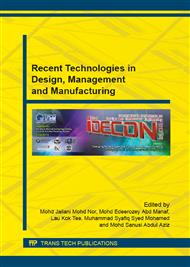p.609
p.615
p.619
p.624
p.631
p.636
p.641
p.646
p.651
Development of Jig for Sintering Hollow Tube Mat
Abstract:
This paper presents the development of a jig for sintering a hollow tube mat. The jig consisted of metal frames, clampers, rails and wheels that were assembled together to hold a stack of hollow tubes in a form of a honeycomb structure. The sintering process involved a large oven where the hollow tube was sintered up to 120°C within two hours. During the sintering process, a partial of plastic parts was melted to allow diffusion around the particle cores. A clamping force from the jig held the tubes to make sure that the molten region around the sintered tubes retained in contact. This gives the compact a sufficient strength to hold together as the heat was removed. The jig developed in this study was capable to produce a hollow cellular mat within the size of approximately 1m (width) x 1m (length) x 1m (height).
Info:
Periodical:
Pages:
631-635
Citation:
Online since:
May 2015
Authors:
Keywords:
Price:
Сopyright:
© 2015 Trans Tech Publications Ltd. All Rights Reserved
Share:
Citation:


